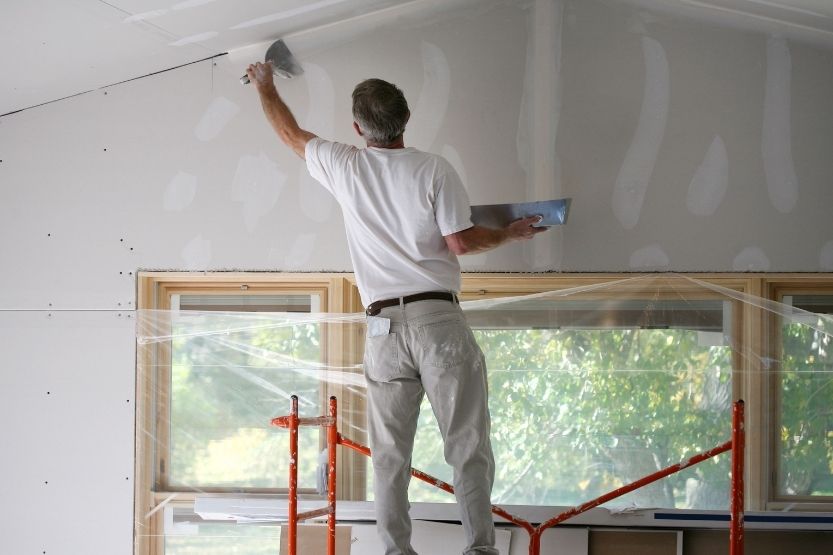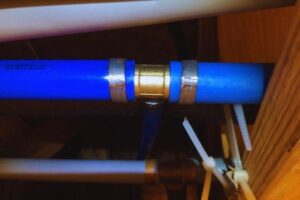Drywalls are beautiful, affordable, and flame-resistant, making them a popular material of choice for walls and ceilings. However, despite its benefits, it can also be a nightmare, especially when not properly installed. A bad drywall job is not just an eyesore, but it can also be a safety threat in your home.
A bad drywall job can result in several problems, including uneven surfaces, visible joints, screw, and nail holes, and crumpled corner beads. In most of these problems, the solutions include using a joint or drywall compound to cover the imperfections. You will also need to sand and dry the surfaces, making them smoother.
Read on to learn more about a drywall job and how to fix it. I will start by talking about what drywall is and follow it up by recommending some of the best solutions.
What Is a Drywall?

A drywall is a gypsum plaster panel between thick paper. Also called custard boards, sheetrock, wallboard, and gypsum panels, among other names, it is a sheathing material that you will find on the interior sides of ceilings and walls.
It is a replacement for lath and plaster. Wet plaster was popular for many years, but it was difficult and time-consuming to install. With this, drywall offers the perfect alternative.
Benefits of Having a Drywall
Are you looking for compelling reasons to have drywall at home? Below are some of the benefits that can convince you to choose it over other construction materials:
1. Affordable
If budget is an issue, then you cannot go wrong with drywall. It is more affordable than plastic walls and panels, making it a popular choice for many homeowners.
2. Aesthetically Pleasing
Aside from its price, the beauty and elegance of drywall attract many people. You can paint it multiple times to give it the aesthetic that you are eyeing. You can experiment with different design ideas for the drywall to stand out.
3. Insulation
Another good thing about drywall is that it provides exceptional insulation. It effectively retains the right temperature in your home. As a result, you will enjoy effective heating and cooling.
4. Fire-resistant
Safety is a major concern for many homeowners. That said, you will surely love drywall because it is fire-resistant. It has additives that allow it to withstand fire or slow down the spread of the blaze.
5. Easy Installation and Repair
Drywall installation is a breeze for professionals with experience and the right tools. Not to mention, fixing a bad job is also a snap. Even the demolition of such a material is easy.
Bad Drywall Job – How to Fix It?
A bad drywall job is frustrating, especially if you paid a contractor to do the task but ended up delivering mediocre results. Luckily, some tweaks promise to address different issues, including those I will discuss below:
Uneven Drywall
Despite the best efforts during the installation of the drywall, it can end up being uneven. Even the slightest difference between sheets can be unsightly. If you do not fix it the soonest, the problem can become more visible over time.
One of the best ways to fix the problem is through a technique known as a skim coating. This is a texturing procedure that will make the uneven portions smoother. You do not need complicated tools and methods. Nonetheless, you must know how to do it right.
How to Fix Uneven Drywall
- Start by sanding the drywall. You do not need to do it on the entire wall. Instead, focus on the specific part that is uneven. Use a sanding pole if you cannot reach higher areas;
- After sanding, apply polyvinyl acetate and wait until it dries. PVA is a primer-sealer that works by making an area more uniform;
- In a five-gallon bucket, combine water and all-purpose joint compound powder. Mix until it is as consistent as peanut butter;
- Spread the mixture in a mudding trough. Apply on the uneven areas of the drywall. Use a flat drywall knife to get rid of visible seams and ridges. It might require several coats; and
- Let it dry and sand. Next, remove the dust from the wall and give it another coat. Let it dry and sand until the drywall is even.
Visible Joints
Drywall installation requires several panels depending on the size of the ceiling or wall. When it is done properly, the connection between the two panels should look seamless. Otherwise, there will be unsightly visible joints. Aside from resulting from an improper job, it can also be because of the aggressive movements, making the panels shift over time.
How to Fix Visible Joints
If there are visible joints in your drywall, below are some of the best ways to fix the problem:
- Use all-purpose mud for coating the visible joints. Use a four-inch drywall knife for spreading the first coat. Meanwhile, for the second coat, use a six-inch drywall knife. The progressive widening of the knives will help in sealing the joints and making the drywall look flatter;
- Leave each coat overnight before you proceed to the next. Once the final coating is dry, sand it with 120-grit sandpaper;
- Alternatively, you can use drywall tape. It holds the compound for creating a smoother finish. If there are bubbles, use a knife to flatten them, making them less visible;
- Another clever solution for hiding the visible joints is to use matte or dark paint. They will help in eliminating any flaw that can be more apparent when the light is bright. It will also help to coat thick paint to hide the joint; and
- Aside from paint, wallpaper is another promising fix for visible joints in drywall. If possible, look for something thick with highly visible textures to make sure that the joints won’t be easily visible.
Nail and Screw Holes

To fasten drywalls, you will need nails and screws. They will ensure that the panels mount in place. Between the two, screws are the more popular option. Regardless of which one is used for the installation, there may be visible holes. At times, they can also pop. If there are holes, the easiest fix is a filling.
How to Fix Nail and Screw Holes
Below are the steps on how you can fix this issue:
- Prepare the surface by sanding. Upon hammering nails or putting screws in the drywall, there can be leftover materials that push outward. You can first cut it with a knife and sand until the surface is smooth;
- Find a high-quality spackling paste to cover the nail or screw hole. You can buy one from the hardware, so you won’t need to make a manual mix. With the paste ready, put it on a putty knife and fill the hole. Swipe downward or sideways to fill the hole. Next, swipe in the opposite direction for wiping off the excess; and
- Once the first layer is dry, apply another layer. Do it by doing the same two-swipe procedure earlier mentioned; and
- Wait for the mixture to dry. Once it is dry, sand the area until it is smooth, and the hole is no longer visible. Finish by painting the surface or leaving it bare as you wish.
Crumpled Corner Bead
A corner bead is an L-shaped metal strip, which is the point where two drywalls meet at a corner. It seals the joint compound, creating a smooth connection between two points. With poor construction, it can be easily prone to dents over time. It can pop loose and crack, weakening the construction of the surrounding area.
How to Fix Crumpled Corner Bead
With this, when the corner bead crumples, here’s a quick guide on what to do:
- Start by marking the damaged section of the corner bead. Next, cut such a portion using a fine-toothed hacksaw. Do not worry if you slightly damage the surrounding parts when cutting. You can quickly fix this problem later;
- After cutting, remove the damaged section of the corner bead. Pry it out. This can be difficult, depending on the manner of installation;
- Next, measure the part of the corner bead that you will need to replace. Cut a new metal bead based on such measurements;
- Use a metal file for smoothing the edges of the corner bead. Position the new bead and secure it using screws or nails; and
- Apply drywall compound and glide it along with the bead, making sure to hide any visible flaw. Dry and sand until it is smooth. At this point, the crumpled bead should look better.
Again, how can you fix a bad drywall job? Fixing a bad drywall job will prevent you from having issues, such as uneven surfaces, visible joints, screw and nail holes, and crumpled corner beads. To fix this imperfection, use a joint or drywall compound. Then, sand and dry the surfaces to smoothen them.
Tips and Tricks for Proper Drywall Installation

Prevent a bad drywall job. Take note of the tips I will list down below to minimize the chances of having an aesthetic problem:
1. Use a Drywall Lift
This is especially important if you are installing the drywall on the ceiling. You can make one yourself using a riser pipe, or you can also rent. This makes it easier to position the drywall without the need for manual holding.
2. Opt for Smaller Drywall Cuts
Opt for smaller drywall cuts, especially if you will install them yourself. This way, it is easier to handle the material. This will also eliminate the need for frequent cutting.
3. Seal Any Exposed Part of the Drywall
Seal any exposed part of the drywall. This will prevent future problems, especially unsightly cracks and joints. When sealing, make sure to sand the surface to achieve the same texture as the rest of the wall.
4. Nail the Surface of the Drywall on a Rigid Structure
Nail the surface of the drywall on a rigid structure. This will provide the support that it needs. Otherwise, this can result in the drywall being tackled down when subjected to force.
5. Use the Right Nails and Screws
This might seem simple, but it is a piece of advice that many people ignore. From the size to the quality, make sure that they are suitable for the drywall installation. Otherwise, you will end up compromising the structural integrity.
6. Work With a Professional
Unsure about how to do it? If you are not confident of your knowledge and skills, then you must work with a professional. The added cost is worth every dollar if you will benefit from their experience and expertise.
Conclusion: Bad Drywall Job – How to Fix It?
A drywall is a great alternative for ceiling and wall materials. It is not only affordable, but it is also beautiful and provides effective insulation. Nonetheless, there will inevitably be a bad drywall job. Some of the most common problems that you can experience include uneven surfaces and visible joints. You can also find holes, and the corner beads can crumple.
Luckily, fixing a bad drywall job is easy. You do not need special tools. You will need to cover it with a joint compound and sand the surface in most instances. Other practical solutions include painting it with a matte or textured finish. Covering the drywall with wallpaper is also a quick fix for a bad job.
Related reading:
Kicked-In Door [How to Repair/Fix]
How Long Does It Take to Fix a Transformer
Carbon Monoxide Detector Going Off – Causes and How to Fix




![Read more about the article Kicked-In Door [How to Repair/Fix]](https://homecarezen.com/wp-content/uploads/2021/09/Kicked-In-Door-300x200.jpg)